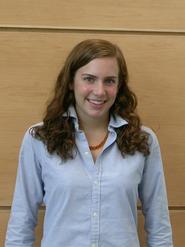
Tessa Olson '08 (Geneva, N.Y.) is a busy girl. A rising junior, she has just completed a paper which she hopes to publish in the Physical Review Letters. A STEP/Dreyfus recipient, Olson returned for her second summer and inherited a project from a graduating senior. This project eventually led to an Emerson grant for "Low Energy Impact Craters" (with her STEP/Dreyfus professor Ann Silversmith, professor of physics again acting as advisor) and a paper titled "Formation of impact craters in granular media."
Olson is looking into the effect of the energy of projectile on the diameter of a crater. In other words, she places a ball in a clamp fixed at a certain height and drops it in a granular media (either fine glass balls or sand). A previous study has found that the diameter is proportional to the projectile energy to the ¼ power.
This study does, however, contain one inconsistency: the scientists performing it claimed that density followed the same rule of proportion as did energy of projectile but had omitted to test the densest balls. Olson found this omission suspect at the time and decided that she wanted to investigate deeper into the relationship between energy of projectile and density. A series of experiments later, she came to the conclusion that uniform diameter with different density proved that the supposed relationship for density was incorrect.
The second section of her research deals with the "dynamics of impact" or where the sand actually goes when you drop a ball on it. To test what happens to the surface sand on impact, Olson sprinkled lines of sand over her beads and dropped a ball, taking before and after pictures to see where the sand had gone. To test the effect of the impact on deeper layers, she layered colored sand and poured wax to set it after the ball drop, then cut it in half to see a cross-section.
Olson is now in her third summer of research and "used to it." She is happy with her inherited project and says that "it's nice to have my own work." The paper is nearly finished and most of Olson's summer will go to writing a curriculum for other STEP/Dreyfus students. She enjoyed her first year with the program: "I like the atmosphere over the summer…everyone was willing to help" and feels that it is a great way to "learn the ropes of doing research."
As Olson explains in her grant proposal, "Most of the research that Hamilton physics professors are doing is too difficult for pre-first-year students to understand. The crater formation project is easy to understand and would give STEP/Dreyfus physics students the opportunity to actively participate in the project." The curriculum will include instructions for simple drops and the replication of Olson's current experiment. It is also, she says, open-ended and there are many other directions that this study can be taken. Low impact craters are currently "quite a vast field," with implications in fluid dynamics and the study of intraparticle reactions between the glass beads which make up Olson's medium.
Olson, a rising junior, is a physics major and thinking of attending graduate school. Her research this summer is funded by the Emerson Foundation Grant Program, which allows students significant opportunities to work collaboratively with faculty members, researching an area of interest.
--Lisbeth Redfield
